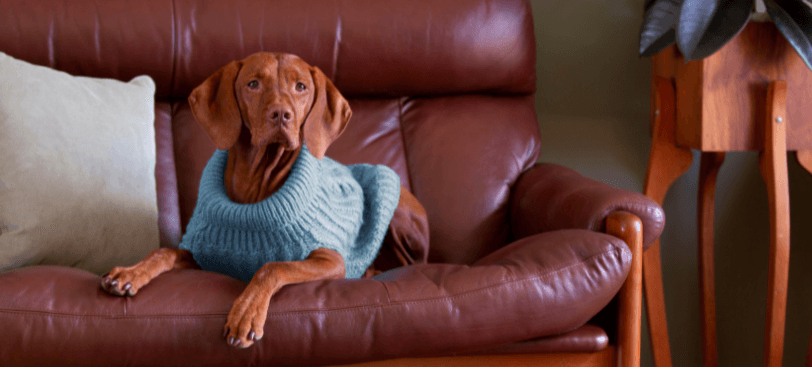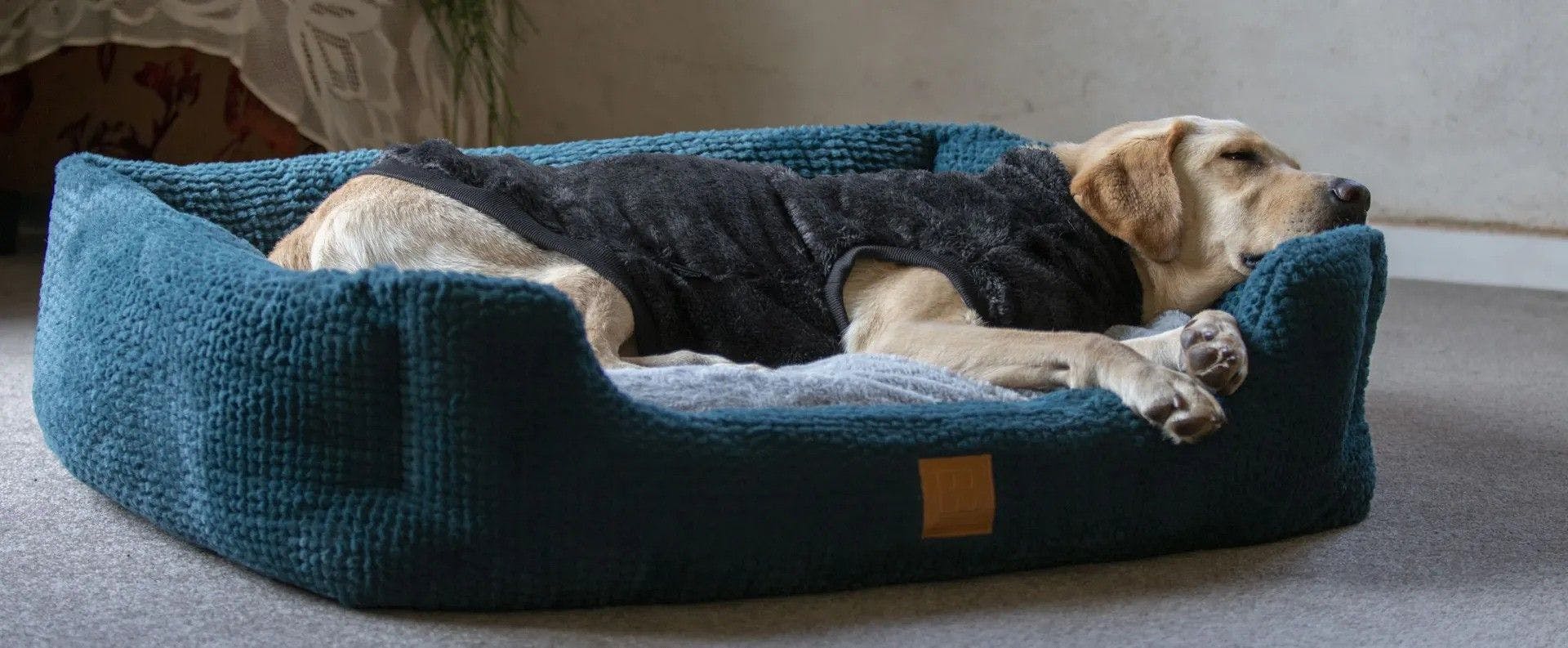
1. Rug Up
Depending on your dog and how susceptible they are to feeling the cold, it might be a good idea to get a few pieces of protective winter clothing for them to keep them nice and toasty on walks – not to mention dry on wet-weather days.
Do Dogs Need Coats In Winter?
Let’s be honest, dogs look pretty damn cute when they’re all rugged up! But do they actually need the extra protection? Whether or not your dog needs a coat depends on several factors, such as:
Their Size
Smaller dogs have a hard time retaining body heart, so it’s a good idea to get them a sweater or a coat for walks on cooler days.
Their Fuzz
Does your dog have a thick, furry coat? If so, they’re unlikely to need additional warmth. Breeds like Pomeranians, Chow Chows, Huskies, Malamutes and Great Pyrenees for example are equipped for cold weather without assistance (although some may benefit from a raincoat or waterproof protection if you’re intending to have them spend hours outdoors in wet weather).
By contrast, short-haired breeds like Greyhounds do better with cold-weather protection (we even have Wriggley Diggley to cater to extra long boys and girls). Even if you do have a long-haired or double-coated breed, it’s good to have a coat or jumper in on hand for extra warmth after they’re groomed.
How cold is it, really?
What’s cold to us may not be so bad for your dog. Temperatures over 7°C are manageable for most breeds. Dogs can overheat as well as underheat, so be sure to monitor your dog and take their coat off if they appear irritated by it. Remember to take your dog’s coat off indoors as well unless your house is poorly heated, and never leave your dog to sleep in clothing as this is a source of discomfort and irritation.
2. Prepare for Indoor Activities
How to Exercise My Dog Without Going Outside
Realistically, you might be spending a lot more time indoors on wet weather days. For active breeds, this can lead to destructive behaviour if they’re not adequately stimulated. It’s a good idea to arm yourself with interactive toys to stimulate your dog and keep pesky behaviours at bay: food puzzles, long-lasting treats and chews and interactive games are a great way to keep your dog busy and, believe it or not, can tire them out as well.
Realistically, you might be spending a lot more time indoors on wet weather days. For active breeds, this can lead to destructive behaviour if they’re not adequately stimulated. It’s a good idea to arm yourself with interactive toys to stimulate your dog and keep pesky behaviours at bay: food puzzles, long-lasting treats and chews and interactive games are a great way to keep your dog busy and, believe it or not, can tire them out as well.
3. Make the Most of Time Outdoors
Variable weather might mean that when you do make it outdoors for walks and stimulation, you’ve got less time than you’re used to. It’s a good idea to stock up on toys that can motivate your dog to make the most out of bursts of good weather. Games like Fetch and Hide and Seek get your dog moving far more than a standard walk, making the most of bouts of good weather and keeping you out of the cold.
It's a good idea to keep a towel in the car to dry your dog off at the end of the walk – paying particular attention to damp paws as this can be a breeding ground for bacteria in the cooler months as it can take hours for the hair in between your dog’s paw pads to dry.
4. Strategically Plan Your Grooming Routine
It’s important to keep up with your grooming routine in winter – often owners forgo grooming for fear their dog will be too cold, but it’s important to keep their coat free from tangles and mats that cause discomfort. This is especially important for paws – the fur between paw pads can remain damp for hours and cause dermatitis and infections. Avoid this by giving them the clip! So, continue with their regular grooming routines - bathing, brushing, grooming and styling, to ensure your dog looks and feels great all year-round.
Book a Groomer
Simply contact your local Petstock store to make a grooming appointment, where you’ll meet our groomers and discuss your dog’s grooming needs.
Book NowTo extend the time between trims, try de-shedding brushes which pull out excess and dead hair. If you must give your dog a clip during the depths of winter, consider getting them some doggy outerwear for extra warmth while they wait for their fuzz to grow back.
If your dog needs a trim, it’s a good idea to do it before the depths of winter so they’re not without their fur coat for the cooler months.
5. Consider Adjusting Their Food Intake
Does Winter Change My Dog’s Nutrition Needs?
In some instances, it’s necessary to adjust your dog’s diet with the seasons. If your dog lives and sleeps indoors and is exercising less in the cooler months monitor their weight and consider cutting back on their portions or swapping out calorie-dense dry food for lighter wet food alternatives.
By contrast, for dogs that live and sleep outdoors or dogs that spend a lot of time exposed to the cold in the cooler months you may need to up their feed to ensure they’re getting their calorie requirements for the day.
If you’re unsure about your dog’s requirements, monitoring their weight is key and chat to your vet if you need help.
Do you know about Petstock Vet?
Find your local Petstock VET clinic for personalised support.
Learn More6. Create a Cosy Space
Does your home get cold in winter? Your dog feels it too! If you find your dog is seeking out warm spaces (like gaps under desks or in wardrobes) or they’re drawn to your couch or bedding areas, it may be that their own bedding areas aren’t warm enough.
Warming beds and blankets are great for keeping your dog warm in the cooler months. Opt for cocoon shapes like bolster beds and line them with blankets or towels to keep it dry. If your dog sleeps outdoors, make sure they have access to an insulated sleep area like a kennel – and ensure it’s clean.

7. Don’t Forget the Senior Citizens
Winter is a tough time for senior pets, particularly for those with joint issues or arthritis as the cold exacerbates symptoms. Keep older pets warm with outerwear, try an orthopedic bed for extra joint support and adjust their diet to accommodate joint support boosters.
Do you want to learn more about caring for pets with arthritis? Read our full article.